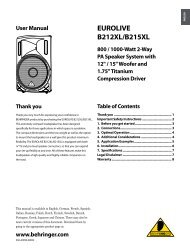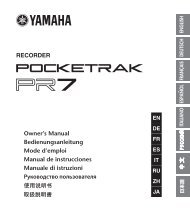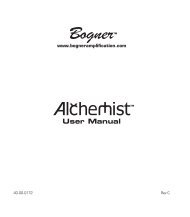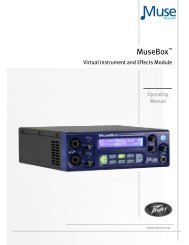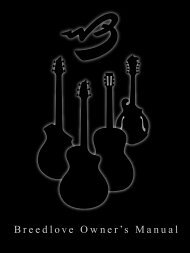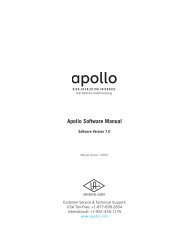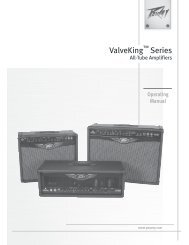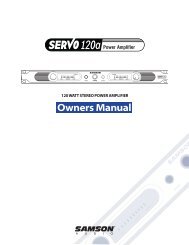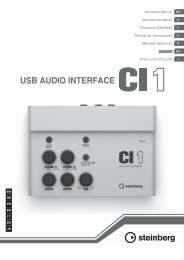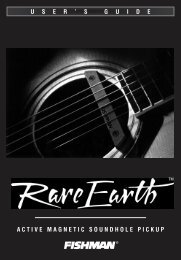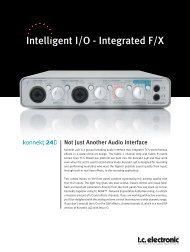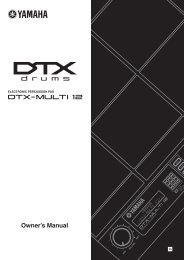microARRANGER Quick Start Guide - Korg
microARRANGER Quick Start Guide - Korg
microARRANGER Quick Start Guide - Korg
You also want an ePaper? Increase the reach of your titles
YUMPU automatically turns print PDFs into web optimized ePapers that Google loves.
Front panel<br />
The music stand<br />
6<br />
30 VOLUME/VALUE (MUTE) A–H buttons<br />
Within this user’s manual, each button pair is marked with an<br />
alphabetic letter (A–H). See “Display and User Interface” on<br />
page 9 for more details.<br />
A corresponding track name is printed over each button pair.<br />
These names show the corresponding track the button pair<br />
affects in the main page of the Style Play mode.<br />
• The left half is for the main page, where you can see the<br />
Realtime tracks, and the Style tracks grouped together:<br />
• The right half is for the Style tracks page, where you can<br />
see each of the accompaniment tracks:<br />
See “Symbols and Icons” on page 11.<br />
Use these buttons to perform various operations on the commands<br />
and functions appearing in the display.<br />
SELECTING Use each button pair to select the corresponding<br />
item in the display (i.e. a track, a parameter<br />
or a command). Use either the left or right button<br />
in a pair.<br />
VOLUME<br />
MUTE<br />
SOLO<br />
While you are in the main pages of any operating<br />
mode, select a track and use these buttons<br />
to change the track’s volume. Use the left button<br />
to decrease it, or the right button to<br />
increase it.<br />
Press both buttons in a pair to mute the corresponding<br />
track. Press both buttons again to<br />
unmute the track.<br />
While in the Style Play, Song Play and<br />
Song modes, you can solo one of the tracks.<br />
Just keep the SHIFT button pressed, and press<br />
both of the VOLUME/VALUE buttons corresponding<br />
with the track you wish to solo.<br />
To exit the solo mode, keep the SHIFT button<br />
pressed again, and press both the VOLUME/<br />
VALUE buttons corresponding to the soloed<br />
track.<br />
VALUE<br />
Use each button pair to change the corresponding<br />
parameter’s value. The left button decreases<br />
the value, the right button increases it.<br />
31 TRACK SELECT<br />
Depending on the operating mode, this button switches<br />
between the various tracks view.<br />
STYLE PLAY MODE<br />
SONG PLAY MODE<br />
SONG MODE<br />
Switches between the Realtime tracks and the<br />
Style tracks.<br />
Switches between the main page (showing the<br />
Realtime/Keyboard tracks), Song tracks 1–8,<br />
and Song tracks 9–16.<br />
Switches between the main page, Song tracks<br />
1–8 and Song tracks 9–16.<br />
The TRACK SELECT LED shows the current page view:<br />
Off<br />
Main page (Realtime tracks, or Song controls)<br />
On 2nd page (Style tracks, or Song tracks 1–8)<br />
Flashing 3rd page (Song tracks 9–16)<br />
32 SINGLE TOUCH SETTING<br />
(F-1–F-4 FUNCTION KEYS) buttons<br />
While in the main page of the Style Play or Backing Sequence<br />
mode, these buttons select a Single Touch Setting each. Each<br />
of the Styles includes a maximum of four Single Touch Settings<br />
(STS), to automatically configure the Realtime tracks<br />
and effects at the touch of a finger. When the SINGLE<br />
TOUCH LED is lit, an STS is automatically selected when<br />
selecting a Style.<br />
In Edit mode, these buttons double as function keys, to<br />
select the corresponding items in the display.<br />
33 SHIFT<br />
With this button held down, pressing certain other buttons<br />
will access a second function.<br />
34 TEMPO/VALUE section<br />
The DIAL and the DOWN/‐ and UP/+ buttons can be used to<br />
control the Tempo, assign a different value to the selected<br />
parameter in the display or scroll a list of files in the Song<br />
Select and Card pages. The VALUE LED shows the status of<br />
this section.<br />
DIAL<br />
Turn the dial clockwise to increase the value or<br />
tempo. Turn it counter‐clockwise to decrease<br />
the value or tempo.<br />
When used while pressing the SHIFT<br />
button, this control always acts as a Tempo<br />
control.<br />
DOWN/‐ and UP/+<br />
DOWN/‐ decreases the value or tempo; UP/+<br />
increases the value or tempo.<br />
Keep the SHIFT button pressed down,<br />
and press either the DOWN/‐ or<br />
UP/+ button to reset the Tempo to the value<br />
that’s saved onto the selected Style.



